Collection Center Web 789 Hold Text
 |
|
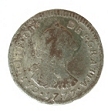 |
|
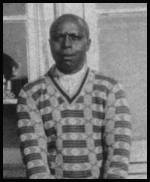 |
|
 SACRF Archaeological Photo Collection is composed of photographs taken during archaeological fieldwork in
SACRF Archaeological Photo Collection is composed of photographs taken during archaeological fieldwork in
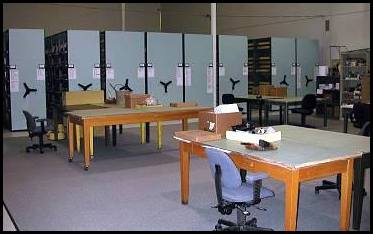
The SACRF Archaeological Photo Collection is composed of photographs taken during archaeological fieldwork in California by the Department of Parks and Recreation. The collection includes photos of cultural landscapes, soil profiles, surveys, excavation sites, and archaeologists at work. For more information on images contact us at (916) 375-5923.

Larry Felton (seated) and Tom Wheeler (standing) during excavations
in the backyard of the Santa Cruz Mission Adobe.

Fort Humboldt State Historic Park
Surgeons' Quarters Reconstruction Excavations, 1983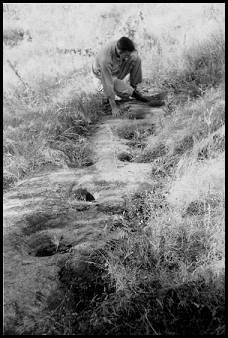
Archaeologist at midden site near Loomis, CA
Milner’s Barbershop
Frank Milner arrived in Allensworth from the Bay Area in 1911 and set up his first barbershop in a small frame house. Milner’s barbershop played an important part in the early Allensworth community. The men of the town met at Milner’s to argue over "all manner of agreements and disagreements." Learn More...
![]()
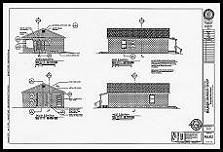
Reconstruction of Mc Coy House
State Park archaeologists excavated in Old Town San Diego to recover information needed to reconstruct a large residence built in 1869 by James McCoy, a well-to-do Irish immigrant who served as San Diego's sheriff and state senator. Learn More...
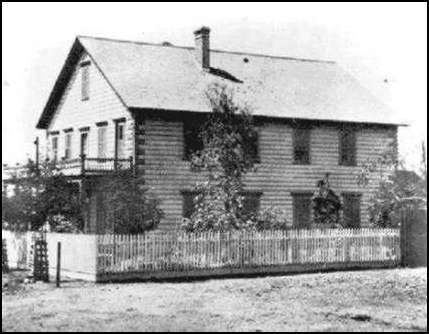
Robert Leavitt, graduate student in anthropology at the University of Nevada, Reno, recently visited the State Archaeological Collections Research Facility in West Sacramento. Robert is currently researching stoneware mineral water jugs and is using the SACRF as a source of data for his MA thesis. Learn More...
.jpg)
.jpg)
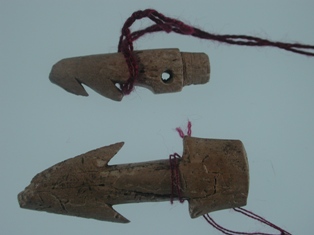
Bone Harpoon Points used by Alaskan Natives to hunt sea otters.
Found at the Native Alaskan Village Site at Fort Ross State Historic Park.
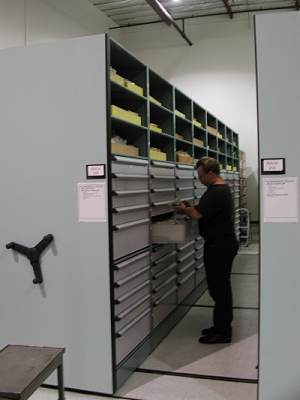
The archaeological collections currently located at the State Archaeological Collections Research Facility (SACRF) derive from a series of excavations undertaken by State Parks archaeologists. Though most of the artifacts come from California State Parks (see Bone Harpoon Points below), a significant number were derived from projects on behalf of other agencies such as Caltrans, the Department of Water Resources and the Army Corp of Engineers.
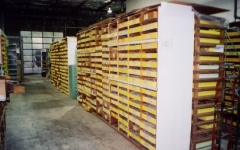
- Enter approximately 1 million artifacts into a parks-wide data base system
- Data entry of information from the artifact catalogs along with information on how to find stored objects
- Better access to the records and photographs associated with archaeological survey and excavation projects
- Digital photography of collections to add to artifact catalog records
- Washing and cataloging artifacts from recent excavations
- Improve access to artifacts in the collections for researchers, archaeologists, curators, historians, scholars, and interpreters
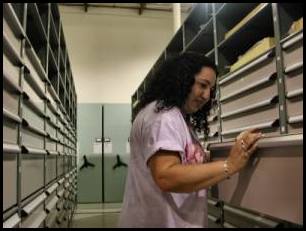
Archaeologist Cristi Assad Hunter searching for an artifact.
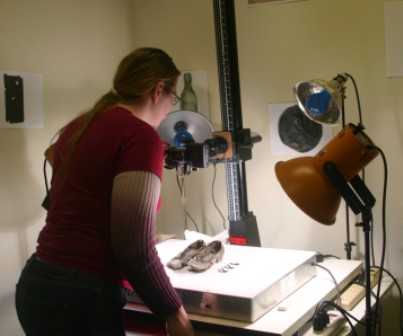
Angela Avery taking photos of artifacts at the
Archaeological Collections Facility in West Sacramento.
The State Archaeological Collections Research Facility may be reached at:
2505 Port Street
West Sacramento, CA 95691
TEL: (916) 375-5923
FAX: (916) 375-5913
Christmas Ornaments from the Rodriguez-Hopcroft Trashpit in Santa Cruz
Glenn Farris
Senior State Archaeologist
During archaeological investigations behind the Santa Cruz Mission Adobe in Santa Cruz California, a trash pit dating to the 1930s was found. Of particular note were a number of glass Christmas lights. These lights were made in Japan in the period between the two World Wars. The trashpit from which they came seems to date to the mid 1930s. About this time, the owner of the property, Roman Rodriguez, died (1936) and his adopted daughter, Cornelia Hopcroft, came to live in the house. It is believed that the items thrown away at this time were from the late Ramon Rodriguez’ belongings.
In his book on Christmas ornaments, Phillip Snyder (1976:122-123), the fascinating historical background of these ornaments is laid out. The first major production of this type of hand-painted milk glass lights was done in Austria by the Kremenetzky Electric Company in Vienna. However, once the United States had entered WWI, trade with Austria stopped. An importer named Louis Szel traveled to Japan about this time and made arrangements for production of these ornaments by local glassblowers. Since glass-blowing in Japan was at an earlier stage of development than the fine quality in Austria, the products were more crudely made. Whereas the Austrian glass was transparent before painting, the Japanese product was generally a translucent white milk glass. Snyder noted that "even Santa Claus bore a distinct resemblance to Buddha."
A sad note in the production of these ornaments is that the glass was mostly blown by Japanese boys from age eight to fourteen. Due to the high lead content in the glass used by the Japanese, blowing these ornaments for up to fourteen hours a day exposed the childrens’ lungs to a heavy concentration of lead and many became tubercular and died.
Once the ornaments had been formed and their electrical filaments installed, they had to be hand painted. For all this exhausting, detailed work the children normally received about 50 sen per day (about 25 cents American at the time).
The Japanese Christmas-lamp industry improved over time and it largely dominated the American market in the 1920s and 30s. During this time small companies took over from the cottage industries and developed more efficient methods of production. This lasted until 1941 when the entry of the United States and Japan into a state of war terminated the trade.
The Christmas lamps found in a Rodriguez family trash pit behind the Santa Cruz Mission Adobe hearken back to the early days of decorative Christmas lights. Such lights are rarely found in an archaeological context and so this discovery lends us additional insight into a Christmas at the home of Roman Rodriguez in the 1920s-30s.
small.jpg)






